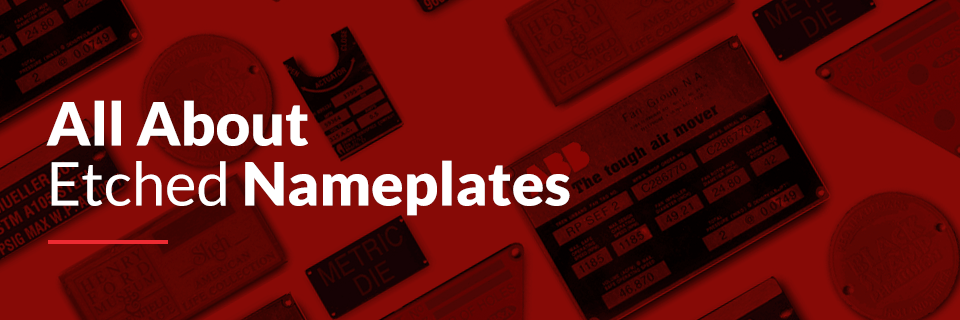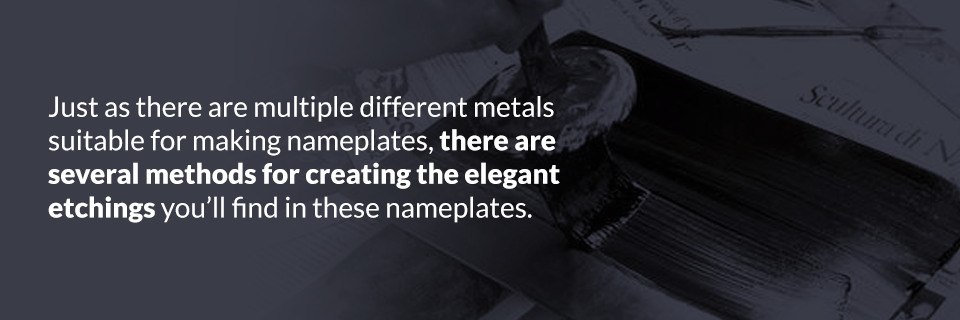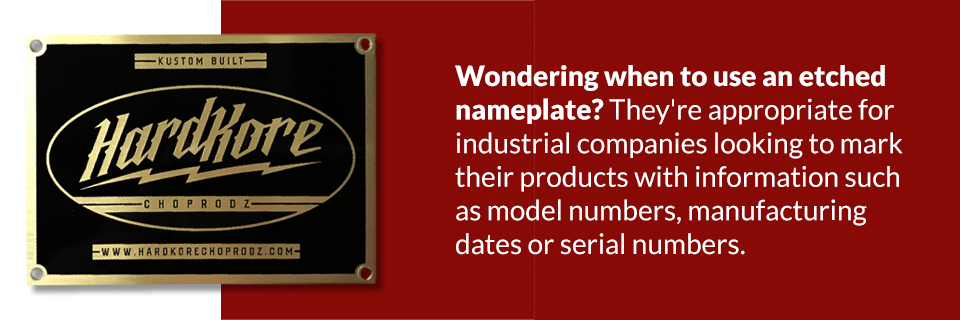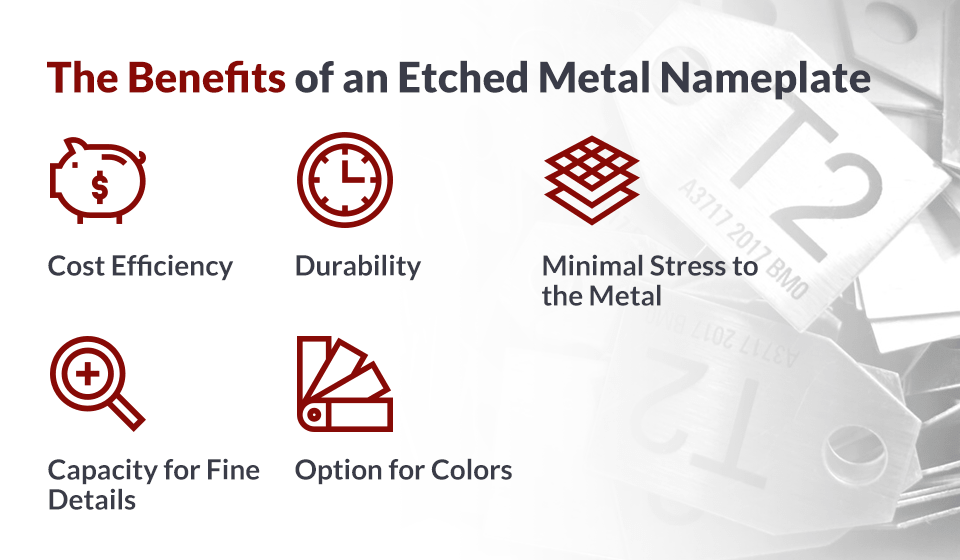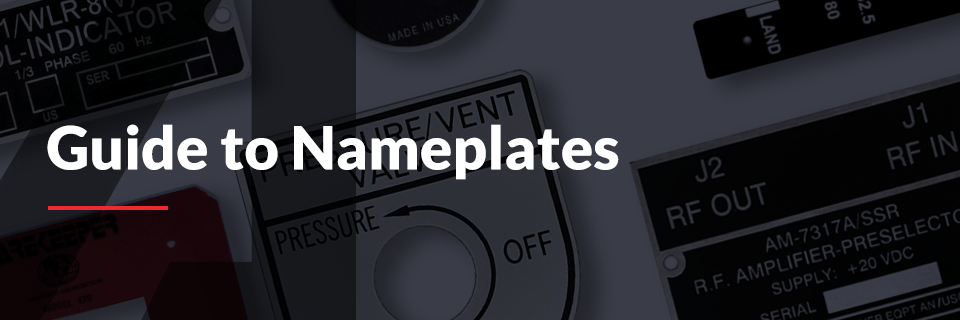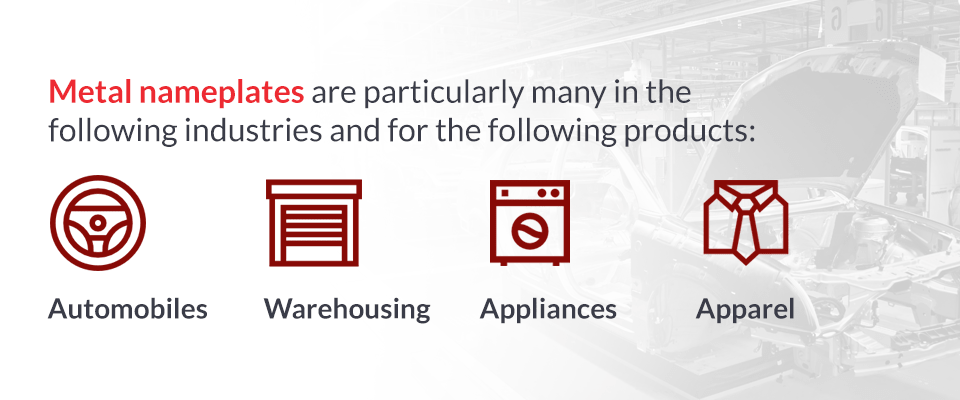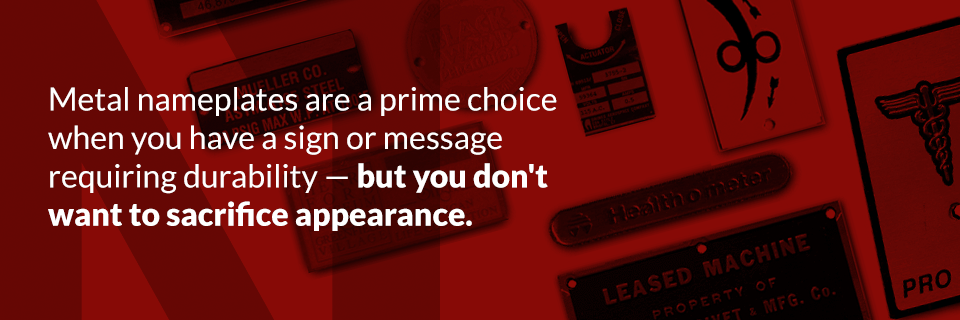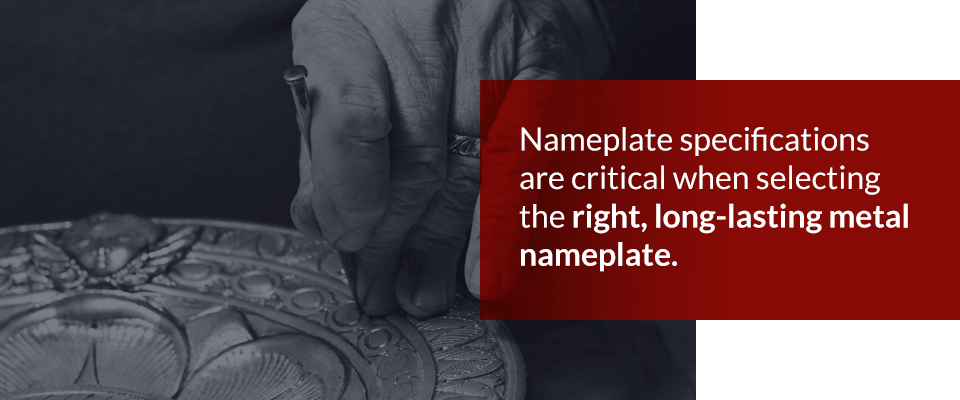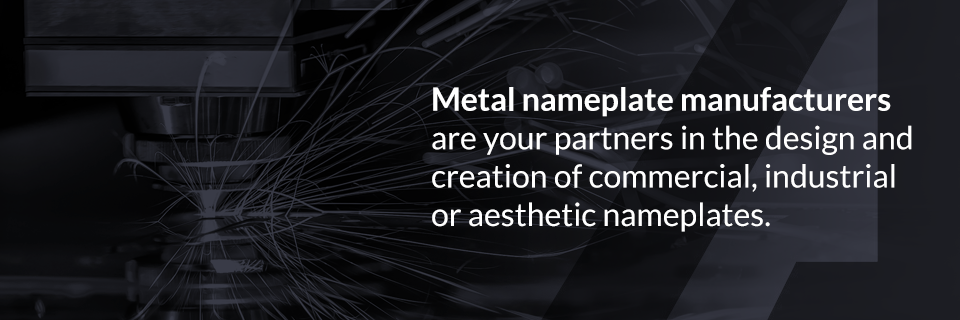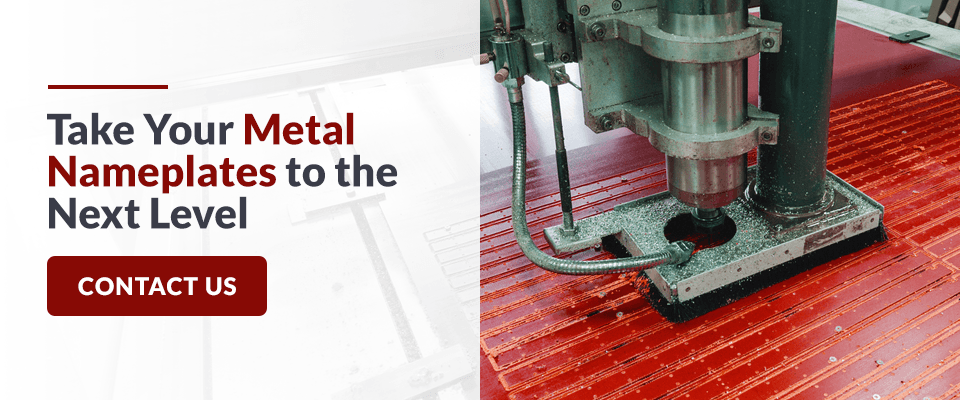All About Engraved Nameplates
Engraved Nameplates
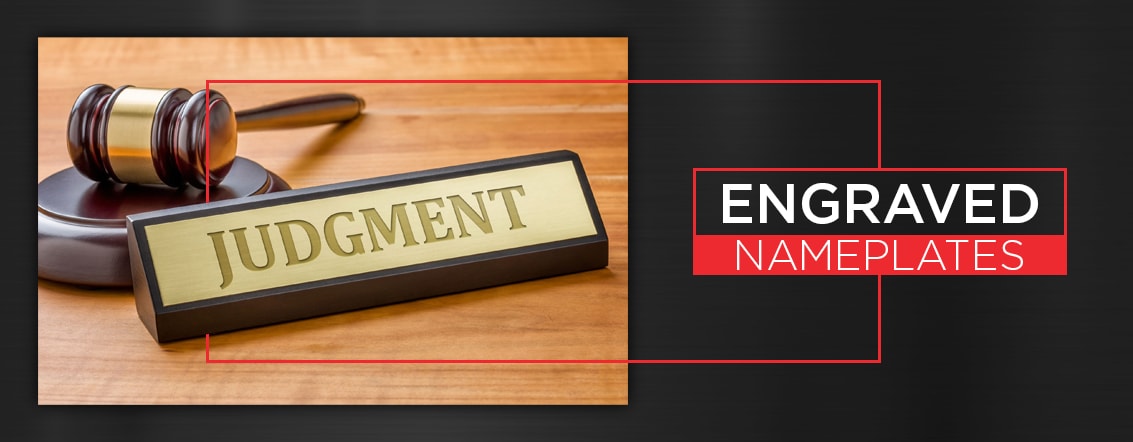
If you are looking for nameplates for your products that will fit your industry’s standards, you have probably stumbled upon engraving. You may be wondering if engraved nameplates are the right option for your business’s needs and how the process works.
Etched, engraved, screen-printed and embossed nameplates all have their benefits. But an engraving can offer many advantages, such as resistance to fading and abrasions and a superior aesthetic that will stand the test of time.
In this guide, we’ll discuss how engraved nameplates are made, their unique advantages and how they can work for your business.
How Are Engraved Nameplates Made?
Engraving nameplates is a precise science. First, you must choose the best material for your purposes. While some textures have a beautiful appearance, others are more durable and better suited to withstand the elements. After you choose a material, submit a design and select a shape, your nameplate will be engraved. A computerized process produces accuracy that’s impossible to get using other imprint methods.
Materials for Engraved Nameplates
The most common materials for engraved nameplates are plastic and metal. Popular choices for engravings include:
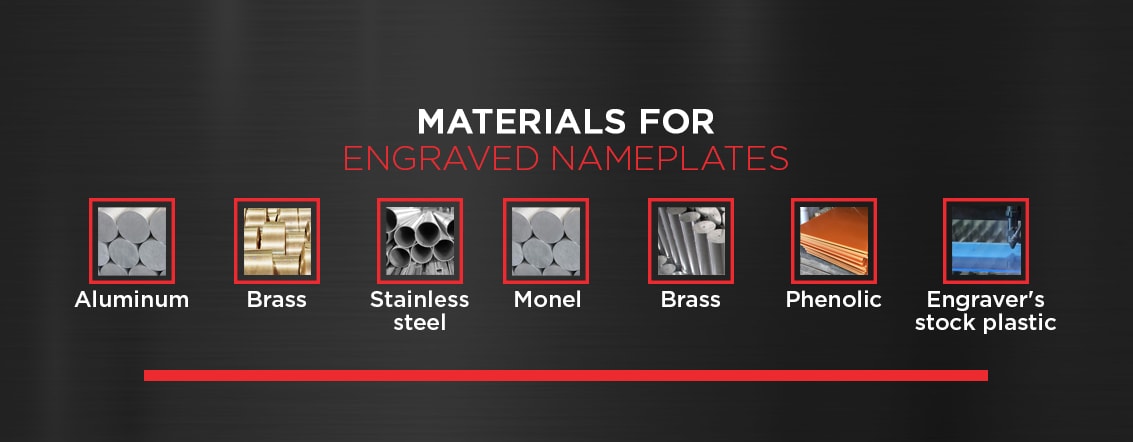
- Aluminum: Aluminum offers a durable and cost-effective material. It’s more common than other pure metals and alloys, making it less expensive. Aluminum is malleable, which makes it great for logos, diagrams or custom fonts with intricate details. As one of the least-dense pure metals, it is easy to shape and adhere. Many admire aluminum for its natural coloration, which varies depending on the metal’s source and its finish.
- Brass: This metal gives off a brushed finish and has many aesthetic nameplate applications. Plaques, mounted nameplates, engraved awards, and emblems all standout against its gold or scarlet color. In industrial settings, this zinc and copper alloy is durable and malleable when heated.
- Stainless steel: A popular choice for almost any nameplate, stainless steel is stain resistant, anti-corrosive and sturdy. Impervious to most nicks and dents, stainless steel also provides a mill finish and a natural sheen, making it as attractive as it is tough.
- Monel: Monel is an alloy of nickel and copper that offers another choice for outdoor use. With traces of iron, carbon, and silicon, monel is resistant to wind, rain, and other elements. The naturally dark bronze or the high-polished finish of nickel-silver offer elegant branding.
- Phenolic: If you need a non-conductive material, try phenolic. Phenolic is a material made from a thermoset resin that is low-glare and scratch-resistant. While it’s not recommended for outdoor use, it is a great option for nameplates on indoor electrical equipment.
- Engraver’s stock plastic: Engraver’s stock allows for a two-toned finish, so the print will match your brand’s color palette. Plastic is a low-cost option that will work for most indoor applications.
How Engraving Works
Engraving creates a recess in whichever material you’ve chosen for the engraving. The process uses a rotary cutting tool synced with a computer, which creates a clean edge and cuts to a small depth.
Engravers might also use a carbon dioxide laser, which creates a more shallow incision. Laser engravings can also produce barcodes alongside custom text and graphics. With laser engraving, a high-heat laser beam cuts into the metal or plastic and vaporizes this material to reveal a cavity.
An engraving can be filled in with paint or left without fill, depending on your preferences.
If you have specific needs, you can choose to send a blueprint of your design and specifications to our specialists to confirm an engraved nameplate will meet your needs. Or you may send an artwork file and select from a variety of shapes, sizes, and materials from our quote form. At American Nameplate, we accept AI, EPS, PDF, CDR, DWG, and DXF file types.
After submitting materials, you will receive a proof to ensure the plates meet all of your requirements. After your approval, the nameplates will go into production. Production time will vary depending on your order specific variables.
At American Nameplate, we offer some of the fastest turnaround times in the business, with a standard of two to three weeks. We also provide an Eagle Express service for time-sensitive requests. If you need to reorder a nameplate you’ve already ordered from us in the past, Eagle Express will send your order within three business days. For new requests, we will ship within six business days after proof approval.
Benefits of Engraving Nameplates
Between its durability and superior workmanship, engraving offers several key advantages. Engraving allows you to meet the highest standards, so crucial information will last as long as the products you manufacture do. Engraving is precise enough to carve bar codes, specific fonts, and logos.
These benefits combine to produce nameplates a cut-above those created using other techniques. Some of the most significant benefits of engraving nameplates include:
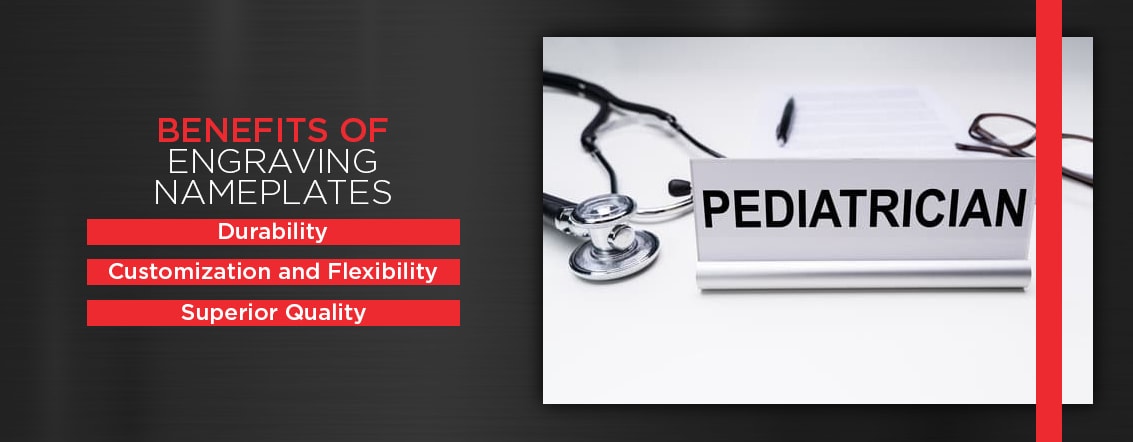
Durability
Some engravings carved in ancient Rome are still readable today. On the face of historic buildings or churches, you’re likely to find plaques that were engraved hundreds of years ago. Engraving stands the test of time. Engravings have a deeper and cleaner line than etchings or stamps, which helps them resist wear.
Thanks to detailed computer codes and precise cutting tools, engraving is more accurate than etching or silk screening. Against the right material, the crisp edge can endure many environments, including:
- Extreme temperatures
- Rough surfaces and abrasion
- Demanding weather conditions
- Corrosive substances
Customization and Flexibility
Engraved nameplates offer more customization. While you can stamp a nameplate, you’ll be limited to the typefaces that the nameplate manufacturer has in stock. But with engraving, screen printing, and etching, various fonts, graphic, or design you come up with can be engraved into metal or plastic.
You can carve essential safety procedures alongside illustrative pictographs, or serial numbers and contact information alongside a beautifully rendered logo.
With laser engraving, you will get even more flexibility. You can work with varying degrees of thickness for both materials and line depth. But, laser engraving also allows you to engrave onto rough, rounded, or uneven surfaces with ease.
Superior Quality
The strength, legibility and professional look of engraved nameplates make them so versatile. They also stand out for their distinct appearance, perceivable by sight and touch. It’s easy to see the craftsmanship of an engraved nameplate, and using one on your products will be a testament to their quality, too. Engraving has a long history, so engraved fixtures look old-fashioned, smart and sophisticated.
Because both rotary and laser engraving uses such precise cutting tools, you can expect the quality and accuracy of the engravings will be consistent, even on orders in the thousands or higher.
Common Uses and Applications for Engraved Nameplates
Many industries use engraved nameplates when their products or machinery need to be custom. Logos, branded graphics, informative diagrams and more look best engraved.
We often think of engraved nameplates for plaques, awards and mounted plates, but they are practical in the industrial space as well. You will often find engraved labels on motors, pumps, asset identification tags, and industrial machinery.
Engraved nameplates last for years, which makes them ideal for permanent signage and safety information. For example, industrial laboratories use engraved nameplates to label fixtures, such as eyewash stations, and to print safety instructions on the equipment. Engraved signage for fire exits, warning signs and traffic route labels on warehouse floors are visible and permanent.
Manufacturers, rental companies and businesses with lots of equipment to keep track of should consider laser-engraved asset identification tags. Engraved barcodes are peel and fade resistant, helping you track your assets for years to come.
Engraved metal nameplates are heat resistant and can provide readable instructions, even in harsh environments. In areas like boiler rooms that need quick in-the-moment instructions, engraved nameplates can provide quick operating instructions for valve plates or pump tags.
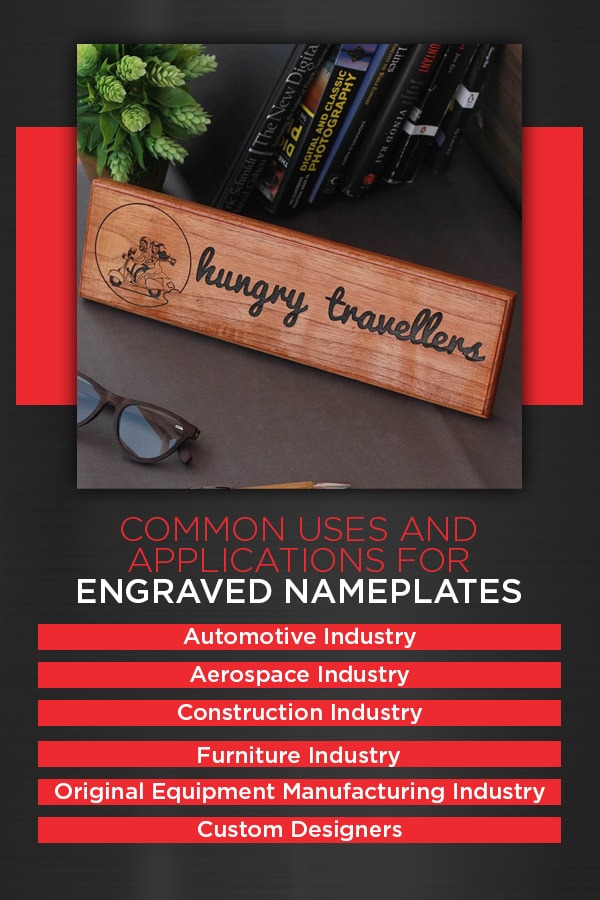
Some other industries that can benefit from engraved nameplates include:
Automotive Industry
Vehicles must pass thorough inspections and federal regulations, so proper identification should be visible on all parts of an automobile. To keep up with competitors, branding that won’t fade with time is critical for the automotive industry. Because of this, engraving is an excellent way for automotive manufacturers to display information for dealers, mechanics, and customers. Serialized parts can help ensure replacement parts are correct for a car’s make and model.
Nameplates preserve records for companies and contractors, making it easy for them to keep track of parts and reference information during resales and accidents.
Aerospace Industry
Airplanes and airplane manufacturers face increasingly high standards for machinery and parts. In an industry where safety is paramount, proper labeling can save lives.
In the aerospace business, we recommend pairing your engravings with durable metal. Metal engraved nameplates can show inspectors and workers vital information, such as technical specifications, serial codes, dates, places of manufacturing and warning labels. This helps planes pass inspections and pilots avoid disasters.
Labeling lets employees keep track of parts, eases navigation through supply chains and aids in resales, organizational changes, and disasters.
Construction Industry
If you manufacture construction equipment and tools, your instruments are being used every day at job sites. Having branded nameplates will help associate your quality products with your name. Construction workers and site managers will be able to tell whose products they are using with a customized nameplate featuring your logo.
For construction businesses, engraved nameplates offer a way to improve communication with your employees. Having printed safety instructions, policies and OSHA regulations on heavy-duty equipment keeps your employees safe and increases trust. While you should always train workers before they operate machinery, it can be easy to forget information like weight limits or the proper PSI needed for tires. Nameplates make this information readily available.
Whether you are a manufacturer or a construction manager, engraved nameplates can help you clearly label your equipment and resist wear. Your signage can be read even in bright light, and will not fade even after years of harsh sunlight.
Furniture Industry
In the furniture industry, an engraved nameplate adds an elegant branded element to any piece that will last as long as the product does. Branding lets customers know who manufactured their goods years later when it’s time for them to redecorate. In addition to adding brand visibility to these pieces, a nameplate offers a space for contact, warranty or manufacturing information.
Proper labeling of furniture can offer a benefit to inventory management for both furniture manufacturers and furniture rental companies. They can help you record pieces during large production runs, or help you track and prove ownership of your rental collection to prevent property loss.
Original Equipment Manufacturing Industry
For original equipment manufacturers, nameplates are essential for helping end-users stay safe when working with new equipment and tools. For items that will withstand harsh weather or wear and tear, an engraved nameplate will ensure that all safety information and protocols stays firmly adhered to their surfaces.
Engraved nameplates can feature technical specifications, manufacturing locations, serial numbers and warnings for products. The durable markings of a recessed engraving ensure this information stays clean and readable, no matter the conditions. Original equipment manufacturers need to meet strict regulations on the permanence of markings and labels, so make sure to source your engravings from an Underwriters Laboratories (UL) recognized provider. Make sure to contact American Nameplates before selling your products to ensure proper labeling that meets the regulations of your industry.
Custom Designers
For custom designers, one of the most significant benefits of engraved nameplates is their high-customization. When you create one-of-a-kind commission pieces or limited-edition runs, an engraved nameplate offers a high-quality label or branded element to the finished product. The precision of engraving allows you to produce nameplates as unique as the work you create. Including sleek contact information that lets those who work with your product know who to call for their custom-design needs.
American Nameplates allows custom designers to order nameplates in batches as small as one, so you can give yourself credit for the work you produce without worrying about minimum order quantities.
Trust American Nameplates With Your Engraved Nameplates

Engraved nameplates can offer a superior appearance and a durable alternative to other nameplate options. At American Nameplates, we can work with you and the regulations of your industry to ensure an inspection-passing, long-lasting engraved nameplate.
If you are unsure of where to start, we can recommend materials that can withstand the necessary conditions and provide you with the most cost-effective options. If you already have a blueprint or the exact specifications you need for your plates, we can execute your engraving flawlessly in any quantity. Request a free quote today, or send us your artwork and specifications to get started.





